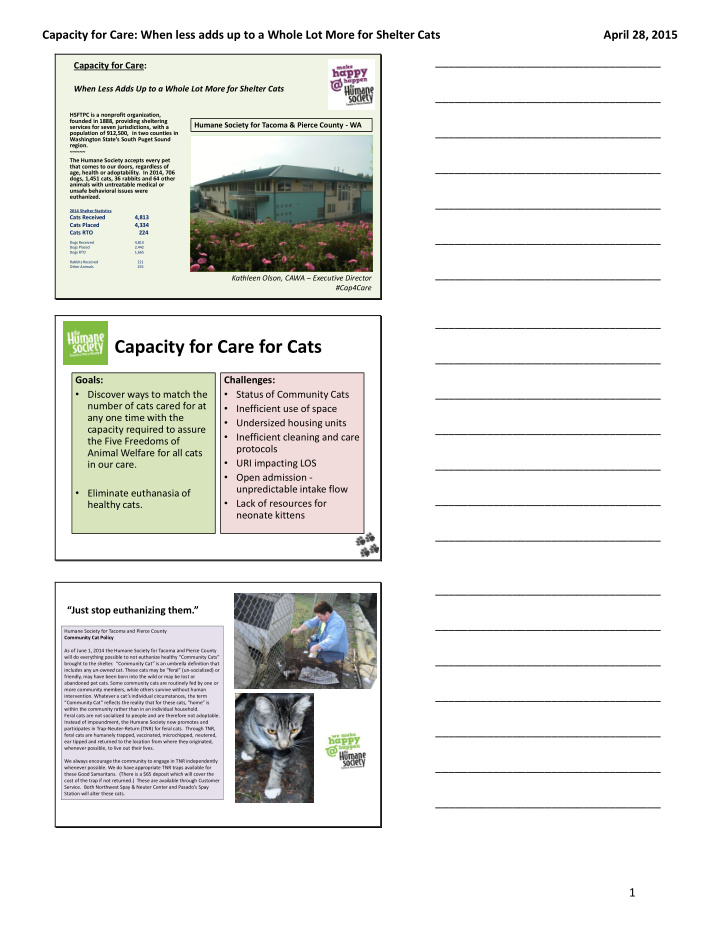



Capacity for Care: When less adds up to a Whole Lot More for Shelter Cats April 28, 2015 ___________________________________ Capacity for Care: When Less Adds Up to a Whole Lot More for Shelter Cats ___________________________________ HSFTPC is a nonprofit organization, founded in 1888, providing sheltering Humane Society for Tacoma & Pierce County - WA services for seven jurisdictions, with a ___________________________________ population of 912,500, in two counties in Washington State’s South Puget Sound region. ~~~~~ The Humane Society accepts every pet ___________________________________ that comes to our doors, regardless of age, health or adoptability. In 2014, 706 dogs, 1,451 cats, 36 rabbits and 64 other animals with untreatable medical or unsafe behavioral issues were euthanized. ___________________________________ 2014 Shelter Statistics Cats Received 4,813 Cats Placed 4,334 Cats RTO 224 ___________________________________ Dogs Received 4,813 Dogs Placed 2,442 Dogs RTO 1,665 Rabbits Received 221 Other Animals 255 ___________________________________ Kathleen Olson, CAWA – Executive Director #Cap4Care ___________________________________ Capacity for Care for Cats ___________________________________ Goals: Challenges: • Discover ways to match the • Status of Community Cats ___________________________________ number of cats cared for at • Inefficient use of space any one time with the • Undersized housing units ___________________________________ capacity required to assure • Inefficient cleaning and care the Five Freedoms of protocols Animal Welfare for all cats • URI impacting LOS ___________________________________ in our care. • Open admission - unpredictable intake flow • Eliminate euthanasia of ___________________________________ • Lack of resources for healthy cats. neonate kittens ___________________________________ ___________________________________ “Just stop euthanizing them.” ___________________________________ Humane Society for Tacoma and Pierce County Community Cat Policy As of June 1, 2014 the Humane Society for Tacoma and Pierce County will do everything possible to not euthanize healthy “Community Cats” ___________________________________ brought to the shelter. “Community Cat” is an umbrella definition that includes any un-owned cat. These cats may be “feral” (un -socialized) or friendly, may have been born into the wild or may be lost or abandoned pet cats. Some community cats are routinely fed by one or more community members, while others survive without human ___________________________________ intervention. Whatever a cat’s individual circumstances, the term “Community Cat” reflects the reality that for these cats, “home” is within the community rather than in an individual household. Feral cats are not socialized to people and are therefore not adoptable. Instead of impoundment, the Humane Society now promotes and ___________________________________ participates in Trap-Neuter-Return (TNR) for feral cats. Through TNR, feral cats are humanely trapped, vaccinated, microchipped, neutered, ear tipped and returned to the location from where they originated, whenever possible, to live out their lives. We always encourage the community to engage in TNR independently ___________________________________ whenever possible. We do have appropriate TNR traps available for these Good Samaritans. (There is a $65 deposit which will cover the cost of the trap if not returned.) These are available through Customer Service. Both Northwest Spay & Neuter Center and Pasado’s Spay Station will alter these cats. ___________________________________ 1
Capacity for Care: When less adds up to a Whole Lot More for Shelter Cats April 28, 2015 ___________________________________ Showcase Available Cats ___________________________________ ___________________________________ ___________________________________ ___________________________________ ___________________________________ ___________________________________ ___________________________________ Portals! ___________________________________ ___________________________________ ___________________________________ ___________________________________ ___________________________________ ___________________________________ ___________________________________ Pathways to Shorter Length of Stay ___________________________________ • Create Cat Team ___________________________________ • Improve Intake Exams ___________________________________ • Start Daily Rounds • Recruit More Foster Homes ___________________________________ • Shelter Neuter Return • Intake Appointments ___________________________________ • If it meows, fix it for free! ___________________________________ 2
Capacity for Care: When less adds up to a Whole Lot More for Shelter Cats April 28, 2015 ___________________________________ Improve Shelter Operations ___________________________________ Switch to one step cleaning protocol ___________________________________ ___________________________________ ___________________________________ ___________________________________ ___________________________________ ___________________________________ ___________________________________ ___________________________________ ___________________________________ Shorten public hours for more staff training and animal care time ___________________________________ ___________________________________ ___________________________________ ___________________________________ Establish a Dedicated Customer Service Call Center ___________________________________ ___________________________________ ___________________________________ & ___________________________________ ___________________________________ Director of First Impressions ___________________________________ Greeter Station 3
Capacity for Care: When less adds up to a Whole Lot More for Shelter Cats April 28, 2015 ___________________________________ Launch a “Foster to Surrender” Program for Neonates ___________________________________ ___________________________________ ___________________________________ ___________________________________ ___________________________________ ___________________________________ ___________________________________ Challenge Ahead: Capital Campaign for Shelter Remodel ___________________________________ ___________________________________ ___________________________________ ___________________________________ ___________________________________ ___________________________________ ___________________________________ ___________________________________ ___________________________________ ___________________________________ ___________________________________ ___________________________________ Thank nk you! ! ___________________________________ Kathle leen Olson, CAWA #Cap4Care Executive Director 4
Capacity for Care: When less adds up to a Whole Lot More for Shelter Cats April 28, 2015 ___________________________________ ___________________________________ ___________________________________ Capacity for Care ___________________________________ When Less Adds Up to a Whole Lot More for Shelter Cats ___________________________________ Presented By Ollie Davidson ___________________________________ Director of Programs and Digital Marketing Tree House Humane Society #Cap4Care ___________________________________ ___________________________________ Brief History ___________________________________ Started in 1971 and became a leader ___________________________________ of the no-kill, cageless movement - proving cats better off in colony environments ___________________________________ Innovative programs, including AAT, Pet Food Pantry, housing FIV+ cats ___________________________________ Mismanagement in the 90s lead to, among other things, severe overcrowding and stalled programs. ___________________________________ ___________________________________ ___________________________________ By 2004 ___________________________________ 350 cats in building, 90% of which ___________________________________ were feral or semi-feral Adoptions around 300 annually and around 400 admissions ___________________________________ Cats were overcrowded in community housing, and health ___________________________________ issues were out of control ___________________________________ ___________________________________ 5
Recommend
More recommend